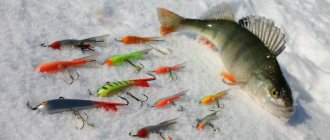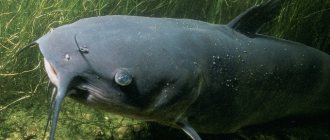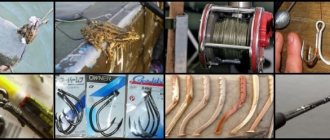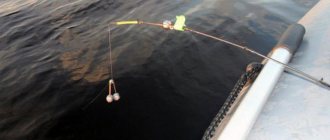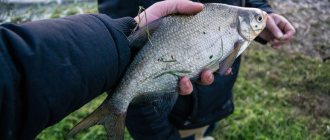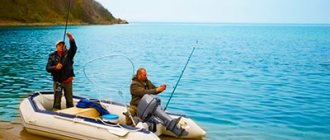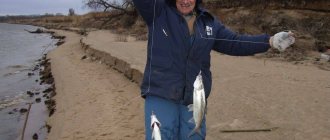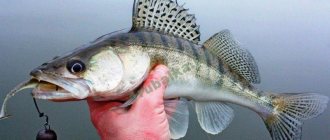Types of rigs for catching pike perch using sprat in winter
In winter, pike perch are caught using sprat in two main ways:
- On a fishing rod using heavy jigs, spinners, jig heads and bottom sinkers;
- On the girders;
Rod accessories
One of the most effective ways is to use heavy pike perch jigs; depending on the depth of fishing and the presence of current, their weight can range from 10 to 30 grams. The shape of the jig can be different; jigs in the form of a drop, a ball and a cone are most often used. Mormyshki can be used lead, copper, brass or other non-ferrous metals.
In terms of color, jigs that are black or dark green in color work best, but you need to have jigs of other colors with you. When fishing at great depths, as well as at night, it makes sense to cover the jig with a phosphor or apply a phosphorus drop.
In addition to jigs, you can use a spoon, a regular jig head, or an eared sinker.
Gear for catching pike perch using sprat in winter is made in two versions:
- With a retractable leash - the most catchy way:
- A triple swivel is tied onto the main line.
- To the swivel we tie a piece of fishing line 30-40 cm long, with a sinker attached to it (a jig, a spinner, a jig head with a hook).
- To the remaining free end of the swivel, attach a branch leash made of a fishing line of smaller diameter, 20-30 cm long with a hook or a light plastic jig.
- The sprat clings to the lower and upper hooks. Moreover, most often the pike perch attacks the sprat, which is planted precisely on the top hook, tied to a retractable leash, which plays the role of an irritant.
- If you have to frequently change bodies of water or fishing conditions, then it is easier to attach the sinker through a carabiner clasp in order to be able to quickly change it.
Can be installed without using a swivel. To do this, we make a loop on the fishing line 80 cm long, then cut it into uneven sections of 35 and 45 cm. We attach a hook to the short edge and a sinker to the long edge.
- One hook. With this setup, catching pike perch with sprat in winter is not so effective, but it also has many of its fans, especially since you can never know in advance what is on the fanged one’s mind.
There are two installation methods:
- When we use a jig, spoon, jig head. In this case, the sinker is attached to the main line directly or through a carabiner. A sprat is attached to the hook and you can fish.
- When we use a regular sinker, in this case a sinker is tied to the edge of the main fishing line, at a distance of 30-40 cm we attach a branch 20-30 cm long, onto which we attach a hook or a plastic jig.
Often fishermen string a piece of sprat on a regular spoon. In this case, the lure becomes more natural, and the predator is tempted not only by the play of the bait, but also by its smell. In addition, when attacking a spoon, the pike perch will not immediately recognize the trick and you will have time to make a normal hook.
Equipment for rigs
Catching pike perch in winter using sprat is very effective when using girders.
In most cases, fishermen use three main types of girders:
- On a flat base;
- Tripod;
- On the rail;
The most common and convenient, in my opinion, are considered to be girders on a flat base; I wrote about the advantages and disadvantages of these types of girders in the article catching pike perch with girders in winter .
The vents are equipped with a monofilament with a diameter of 0.25-0.4 mm. For medium-sized walleyes, 0.3 mm line is sufficient, but if you are hunting for trophy fangs, then you may need thicker monofilament. At the same time, it is always worth remembering that the more delicate the equipment, the more interest it arouses in the fish.
The amount of fishing line for one fishing line is selected based on the conditions that its length should be 10 meters greater than the depth at the fishing point, so that after the bite the pike perch has the opportunity to freely move to the side and taste the prey without feeling a catch.
The only thing where you shouldn’t give pike perch freedom is when fishing among snags, otherwise it will quickly hide among them and break the tackle.
The sinker is a sliding olive, its weight depends on the presence of a current, on average fishermen put olives of 7-10 grams, but on stagnant bodies of water their weight can decrease, and on the river, on the contrary, it becomes larger.
The leash is made of monofilament with a slightly thinner diameter than the main line. The length of the leash is 25-30 cm. A pellet is placed between the main load and the knot connecting the main line with the lead line.
A steel leash, as an element of gear for catching pike perch with sprat in winter, is used only in places where there is a high probability of a catfish bite, and it can significantly reduce the number of pike perch bites. A fluorocarbon leash of 0.35-0.45 mm would be a good compromise, and even if the pike bites it, it’s not so scary, since we will only lose live bait, and not an expensive spoon or jig.
Single hooks are better, No. 6-9 according to the domestic classification.
Gear equipment for catching pike perch with sprat in winter in still waters and on currents:
- Standing pond. A sinker is passed through the main line, then a leash with a hook is tied. A lead pellet is attached between the drive unit and the sinker.
- On the current. We take the edge of the main fishing line and knit a loop 1 meter long. Next, we cut it so that one edge is 30 cm long, and the other 70 cm. A sinker is attached to the short one, and a hook is attached to the long one.
The main thing is active search
The truism for the pikeperch fisherman is that this predator must first be found, and only then caught. The correct search tactics determine the success of fishing. When you find winter anchorage points, you can start using gear for catching pike perch using sprat. We will analyze the features of such fishing in this article. Search tactics are described in detail in the article on winter fishing for pike perch. The behavioral characteristics of pike perch shape search and fishing tactics. In winter, predators stand in strictly defined places at depth, making short raids at night into the feeding shallows close to the pit with accumulations of fry. Tactics for catching pike perch in winter determine the success of fishing for this striped robber.
Tackle for catching pike perch using sprat in winter
Fishing rod
We need a high-quality and powerful fishing rod 50-80 cm long with a hard carbon fiber whip and guide rings. The fishing rod handle should fit comfortably in the hand and be made of heat-saving materials such as wood or neopreon.
Coil
There are no special requirements, it all depends on the preferences of the fisherman. The simplest option is a large inertial reel with a friction brake, capable of holding about 35-40 meters of fishing line. A more expensive, but convenient option is a multiplier; you can also use small inertia-free reels with a spool size of about 1000 dai.
The most convenient, but at the same time expensive option for winter fishing is a multiplier reel; it is more convenient to use than a regular inertia reel with a friction clutch.
There are a number of fishermen who fish without using reels, fishing for prey exclusively with their hands; they put the simplest reels on the rod, which are needed only for winding and transporting the fishing line. True, in this case it is better to use a thicker fishing line, since you will be fishing without a clutch.
fishing line
Monofilament, the thickness depends on the size of the pike perch, 0.3 mm is considered the most optimal, for small pike perches 0.2-0.25 mm is enough, and for trophy pike perch, 0.35 mm may be needed. The thinner the line, the more effective it is to catch pike perch using sprat in winter, especially during the deep winter, but you should carefully calculate your strength and not over-fish.
Peculiarities of pike perch behavior in winter
How does this predator behave in winter?
It is important to understand this point in advance so that the catch pleases you. Pike perch is not caught well during all 3 winter months. So, during the dead winter, its bite decreases significantly, so it becomes difficult to catch it during this period. However, at other times it remains active, moving around the water area in search of food. That is why anglers who go after pike perch need to remember this, so they will have to move across the ice and drill new holes. It is important to remember the peculiarity of pike perch that even if they find a place with food, they will not stand still for long. He swims almost without stopping. Like many predatory fish, it bites perfectly on the first and last ice. At these moments he develops a good appetite. The activity of pike perch largely depends on the weather, for example, if there is a strong north wind, it is better not to go fishing, because there will not be much bite; calmer and more stable weather is preferable for it.
What is the best time to catch pike perch? This moment depends on the month of fishing:
In December, it begins to be caught from 6 a.m. and bites quite well until noon. In deeper winter, the bite begins later - from 7, and sometimes from 8 o'clock.
December
Until the ice sets in (in the first half of the month) there is not much bite. As soon as the first ice is established, the pike perch begins to bite quite well. It is important to remember safety rules when fishing, so until strong ice has formed (at least 10 cm thick), we do not recommend going fishing.
January
This is a period of deep winter, so pike perch don’t particularly bite at this time. To catch this fish you will have to walk around the pond and look for its feeding places. But at this time the fish are not particularly active.
February
In February, pike perch begins to bite intensively again, because this is the time of last ice, when many predators become more active. However, during winter fishing, also do not forget about the safety rules; if the ice has already become thin, then under no circumstances should you go out on it and fish!
How to choose a sprat and place it on the hook correctly
Selecting sprat
Tulka is quite common in the Volga reservoirs and many fishermen prepare it in advance by catching it on a spider near hydraulic structures. You can also buy fresh or frozen sprat in the store.
Catching pike perch in winter will be most effective if you use sprat 4-5 cm long. When you get home, you need to package them in bags of 25-30 pieces and freeze them. They are defrosted directly on the pond, before fishing begins.
During the fishing process, sprat quickly loses its presentation, its color fades, and the tip of its tail breaks, which is why it has to be changed frequently. You need to take at least 50 fish with you to the pond, and if you go for the whole day and expect an active bite, then you may need 150-200 fish.
The remaining thawed sprat is not suitable for reuse and is thrown away.
How to properly hook
There are many different ways to put a sprat on a hook:
- One of the most effective ways is to insert the hook through the eye and out to the back area. The option of simply piercing the head through the eyes is quite unreliable, since the sprat is fragile and often flies off the hook, especially in intense currents.
- In still water bodies, the sprat is often attached to the back under the fin.
- Catching pike perch with sprat in winter can bring good results when, in addition to sprat, we additionally attach bloodworms to the hook.
- Some fishermen even string the sprat onto a hook, like a worm and nothing else, and you can catch it with that.
- During the deep winter period, pike perch may behave rather sluggishly and not want to attack a whole fish, but may well be tempted by pieces of it (head or tail).
How to properly attach sprat to pike perch
When catching pike perch, you need to mount the sprat in a certain way - this affects the number of bites. The attachment with one puncture behind the head is considered unreliable, especially in strong currents. The fish will spin around in the current and sooner or later it will simply fly off the hook. Yes, and pike perch likes to bite off tails, but does not get caught on the hook.
It also happens: Description of how a fish bites
In any case, if there are no bites, you need to experiment with the bait method. Attaching the sprat by the tail may work. If the bite is weak in winter, it is better to generally use small pieces or separate tails. Some anglers pierce the fish with a hook several times, hooking it like a worm.
And the pike perch takes it - after all, first of all, it is attracted by the smell of sprat. Another proven method is a sandwich made from sprat and worms. Sometimes this method saves winter fishing from zero. You can use sprat on other winter gear. Pieces or tails can be hung on the hook of a spoon or balancer; live sprat are good to use as live bait on winter pike perch baits. During the current, the pike perch is enough to put a bait on a dead sprat.
Catching pike perch with sprat in winter - fishing techniques and tactics
In winter, pike perch behaves very sluggishly and practically does not move around the reservoir. Now our task is to find promising areas and fish them. So we will have to walk a lot and drill a large number of holes, regardless of what equipment we use for catching pike perch with sprat in the winter (rod or girder)
It is advisable to initially study the bottom topography using a map, tips from the guard of the reservoir, and also an echo sounder.
The easiest way would be to sail a boat with an echo sounder in late autumn and enter data about promising areas into the navigator, or remember landmarks on the shore.
Fishing technique with a fishing rod:
- Having found an interesting area, we drill about ten to fifteen holes at a distance of 5-10 m from each other and begin fishing.
- We lower the rig with bait to the bottom;
- Raise it to a height of 20-30 cm when fishing in medium and strong currents and 40-50 cm in standing and low-flowing reservoirs;
- At this depth, we begin the game, making smooth rises with the fishing rod up to a height of 20-40 cm, alternating them with pauses. The length of pauses can be from several seconds to 1 minute. The more intense the bite, the shorter the pause and vice versa. Everything is the same as when catching pike perch in winter with a spoon .
- From time to time, instead of going up, you can lightly play with the fish in one place.
There are days when the pike perch behaves too passively and does not want to attack moving targets, so after drilling a series of holes, it is necessary to install two or three fishing rods with the expectation that the pike perch can bite on a non-moving bait. At the same time, we fish the remaining holes in parallel using the above method.
At the end of winter, fishing for pike perch using sprat can take place in different layers of water. The fact is that with warming, small fish become more active, in search of which the pike perch rises to the surface.
When fishing in the current, it is periodically worth giving the opportunity for the current to drag our bait a little, thereby covering a large area of water.
If one of the holes works, then the rod must be quickly re-equipped with a new sprat, since the pike perch stays in schools and there is a high probability of another bite from the catfish. Then, maintaining silence, drill several additional holes around the triggered hole at a distance of up to 1 meter.
Jerky fishing for pike perch using sprat in winter
At promising points, the girders can be placed in a checkerboard pattern or along a curved line. Arranging them along a curved line, we place the first girder at the beginning of the descent, and the subsequent ones as they deepen, so as to fish the entire slope. The piers are placed at intervals of 10-15 meters, so if the length of the slope is short, then we place one at the beginning, another in the middle and a third at the lowest point, making several rows.
Usually a fisherman needs 10 poles for normal fishing, but avid fishermen can take 20-30 poles with them.
On a standing reservoir , the rig is loaded as follows: we wait until the equipment reaches the bottom, then we raise it to a height of 20-50 cm and fix the fishing line on the reel. Here it is necessary to take into account the size of the leash and set the depth so that the sprat is at a distance of 5-15 cm above the bottom level. Then we reel out the tackle, hook the sprat onto the hook, lower it back and insert a signal flag into the groove of the reel.
When fishing in current conditions , we immediately place the sprat on the hook and lower it to the bottom, remove the slack in the fishing line and fix the signal flag.
A straightened flag signals the activation of the vent. In this case, we approach it with maximum caution and without making unnecessary noise. There is no need to rush, especially since the pike perch needs to be given about a minute so that it swallows the bait normally and then we hook it.
A functioning vent must be re-equipped as soon as possible, and several additional holes must be made nearby and vents installed on them.
Where to catch pike perch using sprat in winter
First of all, pike perch that live in the reservoirs of the Volga basin, where this fish is its natural food source, is used to catch pike perch. Practice has shown that in many reservoirs where it is not found in natural conditions, pike perch still eagerly attacks this bait.
Pike perch can be successfully caught using sprat throughout the winter. During the deep winter period, such bait often turns out to be more catchy than spinners and balancers, since very often the pike perch is so passive that the play of artificial baits even scares it away, but the fish or its pieces have a natural appearance and smell that can make the fanged one stir up.
First of all, you should look for pike perch at a depth of about 15 m; they often choose deeper areas. In shallow water, you can hardly find it; the minimum search depth is 4 meters.
Here you should look for bottom anomalies and significant differences in depth, such as:
- A single snag or a cluster of them;
- Placers of boulders and stones;
- Locations close to hydraulic structures;
- Gentle slope in depth with tracks;
- Old river beds, flooded areas of forests, groves or buildings (on reservoirs);
- Colonies of shells;
- Shoals (heels) between deep-water areas;
Pike perch does not welcome soft and muddy bottoms, preferring hard rocky and sandy areas.

